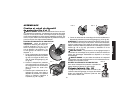
English
6
Mounting Backing Pads and Sanding
Flap Discs
Sanding backing pads are available as optional accessories. Before
fitting the pad, unplug the tool from the power supply and follow
instructions provided with the accessory backing pad.
Mounting Hubbed Wheels
Hubbed wheels screw directly on the grinder spindle without the
use of flanges.
Fitting Wire Cup Brushes and Wheels
Wire cup brushes or wire wheels screw directly on the grinder spin-
dle without the use of flanges. A type 27 guard is required when
using wire brushes and wheels.
CAUTION: Accessories must be rated for at least the speed
recommended on the tool warning label. Wheels and other acces-
sories running over the rated speed can fly apart and cause injury.
CAUTION: Wire brushes can become sharp. Wear work gloves
when handling wire cup brushes.
OPERATION
Starting and Stopping the Tool (FIG. 16)
1. Before connecting the tool to a power supply, be sure the
switch is in the off position by pressing the rear part of the
switch and releasing. If the switch is locked on when the power
is connected, the tool will start unexpectedly.
2. To start the tool, slide the ON/OFF switch
(A) toward the front of the tool.
2. To stop the tool, release the ON/OFF
switch.
3. For continuous operation, slide the
switch toward the front of the tool and press the forward part of
the switch inward.
4. To stop the tool while operating in continuous mode, press the
rear part of the switch and release.
NOTE: To reduce unexpected tool movement, do not switch the
tool on or off while under load conditions. Allow the grinder to run
up to full speed before touching the work surface. Lift the tool from
the surface before turning the tool off. Allow the tool to stop rotating
before putting it down.
Grinding (FIG. 17)
Using a depressed center Type 27 wheel, hold the tool at an angle
of approximately 20˚- 30° to the work for grinding. Most Type 27
wheels are not designed for cutting operations.
Wire Brushing
(FIG. 18 & 19)
Use wire brushes to clean welds, metal
corners, and angles, and to remove paint.
CAUTION: Use a Type 27 guard with wire
brushes and wheels. Operators and others in the
area should wear appropriate eye, face and body
protection. Strands of wire may break and fly off
when wire wheels and brushes are in use.
Sanding With Abrasive Discs
(FIG. 20)
When using an abrasive disc and rubber backing
pad, hold the tool so that an angle of 5° to 15°
exists between the disc and the work, as shown.
Using an angle of 5° to 15° will allow you to pro-
duce a smooth surface. If only the outer edge
of the sanding disc is pressed flat against the
work, the sanding action will be irregular and
bumpy and the tool will be difficult to control.
A
FIG. 16
FIG. 17
20˚-30˚
FIG. 18
FIG. 19
FIG. 20
5˚ - 15°


















